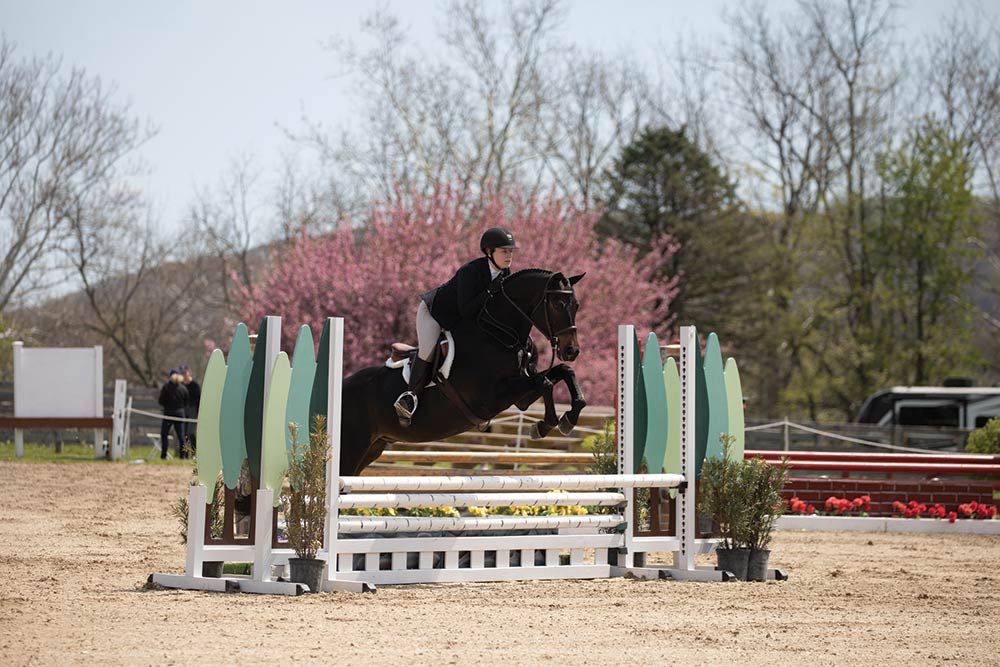 Credit Paws and Rewind. Melinda Bara and Centenary University's Eden Rock at the 2022 Garden State Horse Show.
Credit Paws and Rewind. Melinda Bara and Centenary University's Eden Rock at the 2022 Garden State Horse Show.
New Jersey’s historic Garden State Horse Show was first held in 1951 by The Junior Essex Troop. The Troop had its own farm in West Orange and ran as a military-style organization for boys. By the 1980s, the Troop was no longer an active organization, but some of the former members used the running of the show as an annual reunion. Former manager Tim Cleary joined the Troop at ten-years-old and managed the show for 33 years.
Over time, the show went from a one day show to a three day show and was known as the largest junior-only horse show on the East Coast. Here it became known as the Garden State Horse Show. It was remembered for its fun atmosphere and challenging outdoor course which included galloping across hills and streams. By 1989 the show had moved to the Sussex County fairgrounds, expanded to a five-day competition which was now open to both juniors and adults, and became the largest AA hunter/jumper show in New Jersey.
On the 60th anniversary of the show, it expanded to include the Garden State Preview Show which would make the competition a total of seven days, held over two different weeks. At this time, the show hosted up to 1,500 competitors with divisions of 70 horses, and over 1,000 spectators.
In 2019, the show spent a year at the U.S. Equestrian Team headquarters in Gladstone, NJ where it went from a seven-ring competition to just one ring. Although a fun experience for exhibitors to show at such a prestigious venue, a one ring venue was not a wise permanent choice for such a large horse show. Here the show had greater sponsorship requirements and had to run for nine days to accommodate the smaller venue.
After that year, it was decided that a change in management was needed. It was a competition that Nona Garson had participated in for fifty years so she and her partner George D’Ambrosio seemed to be the perfect fit. 2020 was their first year hosting the show at their own The Ridge at Riverview, and even though the show was postponed to August rather than May due to covid, the feedback from exhibitors was positive.
At the new venue, the facility hosted two days of unrated showing followed by the remainder of the week’s ‘A’ show. Featured classes during the rated show include $25,000 Garden State Grand Prix, $7,500 Ted Grant Welcome Stake, $5,000 USHJA National Hunter Derby, $2,500 Garden State Hunter Derby, and $1,500 jumper classics. Some of the most notable sponsors of the event include Equijet, Running S Equine Veterinary Services, Stal De Eyckenhoev, Eastern Hay, Centenary University, and The Nature Conservancy.
This year’s preview show took place April 30-May 1. Nona Garson served as course designer for these days, while Steven Rivetts judged and Diedre Would was show secretary. Some of the larger classes of the preview show included the Outreach Itty Bitty Jumpers with as many as twelve in one class, the Outreach M&S/NJPHA/NJHSA Ch/Ad Medal 2’6” with seven, and Outreach Schooling/Suitable Hunters with eight.
The ‘A’ show was judged by Seven Rivetts, Ken Okken and Patricia Jellerson, while Juan De Dios Alvarez and Robert Allen were course designers. Joni Moloney served as the steward, Nona Garson as the manager and Deidre Would as secretary.
Some of the larger classes during the rated competition included the Garden State Hunters with six and the .80m jumpers with five. Rather than hosting the $2,500 Garden State Hunter Derby, management chose to hold the Riverview Hunter Derby in its place with a trophy for the winner instead of prize money. It drew three entries. The $7,500 Ted Grant Welcome Stake had three entries with Caroline Martin taking the top prize, while the $25,000 Garden State Grand Prix had no entries. The show also offered Ladies Side Saddle with 3’ over fences classes and an under saddle with three entries.
New Jersey’s most historic horse show, The Garden State Horse Show has shifted managers and venues many times throughout its 71 years and has seen many changes in its exhibitors and spectators. In its years at the Sussex County fairgrounds the show boasted as many as 1,500 competitors and 1,000 spectators, and now with smaller numbers, the show provides a more intimate environment with classes for all levels.




